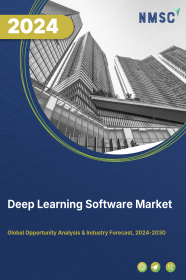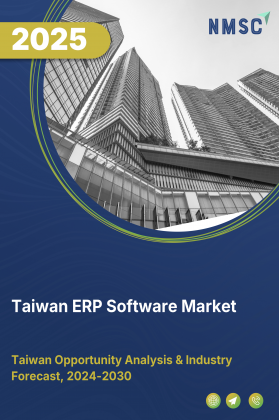
Deep Learning Software Market by Component (Software and Service), by Application (Image Recognition, Signal Recognition, Data Mining, and Others), and by Industry Vertical (Security, Marketing, Automotive, Retail & E-Commerce, Healthcare, Manufacturing, Law, Agriculture, Fintech, Human resources, IT & Telecommunication, BFSI, and Others)- Global Opportunity Analysis and Industry Forecast 2024-2030
Market Definition:
The Deep Learning Software Market was valued at USD 27.2 billion in 2023 and is predicted to reach USD 236.3 billion by 2030 with a CAGR of 36.2% from 2024-2030. Deep learning software is an artificial intelligence-based software with a set of algorithms that imitates the functioning of the human brain in processing data.
The software enables machines to learn without human supervision and grants them the ability to recognize speech, translate languages, detect objects, and even make data-driven decisions. It uses the concept of artificial intelligence and machine learning to help companies, organizations, research centers, and universities derive insights from data and use that data to drive innovation. It further helps in business development such as identifying trends and customer buying patterns in the long run that benefit the organization.
Market Dynamics and Trends
The demand for deep learning is increasing due to its rapid adoption in industries such as healthcare, manufacturing, and automotive among others. This is attributed to the advancements in data center capabilities, high computing power, effective performance, and the ability of deep learning software to perform tasks without human intervention.
In addition, the increasing deployment of artificial intelligence and IoT, combined with the implementation of smart devices in an organization can save time and money, which is accelerating the growth of the market. Moreover, the market for deep learning software is expanding as smart homes become more popular. This is because deep learning software converts speech to text, which is a key component of voice control in a smart home.
However, the complex algorithms used in the deep learning software paired with the lack of skilled professionals are the factors that are expected to restrain the growth of the market during the forecast period. On the contrary, the advancements in AI and machine learning technologies in industries such as travel, tourism, and hospitality are expected to provide ample growth opportunities for the deep learning software market in the future.
Market Segmentations and Scope of the Study
The deep learning software market is segmented on the basis of components, application, industry vertical, and geography. On the basis of components, the market is divided into software and service. The software segment is further bifurcated into solution and platform. The services segment is also further subdivided into installation, training, and support & maintenance. On the basis of application, the market is categorized into image recognition, signal recognition, data mining, and others. On the basis of industry vertical the market is divided into security, marketing, automotive, retail & e-commerce, healthcare, manufacturing, law, agriculture, fintech, human resources, IT & telecommunication, BFSI, and others. Geographic breakdown and analysis of each of the aforesaid segments include regions comprising North America, Europe, Asia-Pacific, and RoW.
Geographical Analysis
North America held the lion’s share in the deep learning software market in 2021 and is expected to continue its dominance during the forecast period. The increasing adoption of this software by various universities and institutions for research and development activity to conduct scientific innovation is expected to provide a positive impact on the growth of the industry in the region.
For instance, in July 2020, the Australian Catholic University (ACU) used Microsoft’s Power BI and Azure data platform to provide a single view of student development. It supports students who may need extra help or are at risk of dropping out of the university entirely. Thus, such innovations are significantly driving the growth of the market. Moreover, the increased usage of deep learning software in cloud-based services and adoption of advanced technologies in various industries such as healthcare, automotive, and IT & telecom to drive innovation is expanding the North American deep learning software market.
Also, the presence of numerous key players such as Microsoft, Clarifai, Nuance communication, and IBM which are adopting several market strategies for expanding their businesses is driving the North American deep learning software industry to expand at a rapid pace. For instance, in Nov 2022, IBM Corporation introduced a new software that is designed to assist businesses in breaking down data and analytics barriers so they can quickly make data-driven decisions and handle unpredictable interruptions.
Asia Pacific is expected to show a steady rise in the deep learning software market during the forecast period due to proliferating demand for smartphones, computers/tablets, and other electronic devices in developing and highly developed countries such as China, Japan, and India. Moreover, the increasing applications of robotics, IoT, AI, and machine learning in countries such as China, India, Japan, and South Korea is further boosting the growth of the deep learning software market in the region.
Competitive Landscape
The deep learning software market comprises various market players such as Clarifai, Inc., Intel Corporation, NVIDIA Corporation, Microsoft Corporation, Google LLC, Samsung Electronics, IBM Corporation, Amazon Web Services, Qualcomm Technologies, Inc. and Nuance Communications. These market players are adopting various strategies such as launches and collaborations to maintain their dominance in the global deep learning software market.
For instance, in October 2022, Clarifai launched Clarifai Community, an artificial intelligence-based community for creators and developers. This platform uses deep learning software enabling users to develop and share artificial intelligence resources throughout their enterprise or organization. Also, in October 2020, Microsoft Azure collaborated with NVIDIA AI team to improve the AI-powered grammar checker in Microsoft Word. This deep learning software helps users to avoid grammatical mistakes and increase efficiency. The web version of Microsoft word can now tap into NVIDIA Triton Inference Server, ONNX Runtime, and Microsoft Azure Machine Learning to provide this smart experience.
Key Benefits
-
The deep learning software market report provides a quantitative analysis of the current market and estimations through 2022-2030 that assists in identifying the prevailing market opportunities to capitalize on.
-
The study comprises a deep dive analysis of the deep learning software market trend including the current and future trends for depicting the prevalent investment pockets in the market.
-
The information related to key drivers, restraints, and opportunities and their impact on the deep learning software market is provided in the report.
-
The competitive analysis of the market players along with their market share in the deep learning software market.
-
The SWOT analysis and Porter’s Five Forces model are elaborated in the study.
-
Value chain analysis in the market study provides a clear picture of the stakeholders’ roles.
Key Market Segments
By Components
-
Software
-
Solution (SDK/Software Framework)
-
Platform/API
-
-
Service
-
Installation
-
Training
-
Support & maintenance
-
By Application
-
Image Recognition
-
Signal Recognition
-
Data Mining
-
Others
By Industry Vertical
-
Security
-
Marketing
-
Automotive
-
Retail & E-Commerce
-
Healthcare
-
Manufacturing
-
Law
-
Agriculture
-
Fintech
-
Human Resources
-
IT and Telecommunication
-
BFSI
-
Others
By Geography
-
North America
-
U.S
-
Canada
-
Mexico
-
-
Europe
-
Germany
-
France
-
Italy
-
Spain
-
United Kingdom
-
Russia
-
Sweden
-
Rest of Europe
-
-
Asia-Pacific
-
Australia
-
China
-
India
-
Japan
-
South Korea
-
Indonesia
-
Singapore
-
Rest of Asia-Pacific
-
-
RoW
-
UAE
-
Brazil
-
South Africa
-
Israel
-
KSA (Kingdom of Saudi Arabia)
-
Turkey
-
Remaining Countries
-
REPORT SCOPE AND SEGMENTATION:
|
Parameters |
Details |
|
Analysis Period |
2023–2030 |
|
Base Year Considered |
2023 |
|
Forecast Period |
2024–2030 |
|
Market Size Estimation |
Billion (USD) |
|
Market Segmentation |
By Components (Software and Services) By Application (Image Recognition, Signal Recognition, Data Mining, Others) By Industry Vertical (Security, Marketing, Automotive, Retail & E-Commerce, Healthcare, Manufacturing,Law, Agriculture, Fintech, Human Resources, IT and Telecommunication, BFSI, Others) |
|
Geographical Segmentation |
North America (U.S., Canada, Mexico) Europe (Germany, France, Italy, Spain, United Kingdom, Russia, Sweden, Rest of Europe), Asia-Pacific (Australia, China, India, Japan, South Korea, Indonesia, Singapore, Rest of Asia-Pacific), Rest of the World (UAE, Brazil, South Africa, Israel, KSA, Turkey, Remaining Countries) |
|
Companies Profiled |
Clarifai Inc, Intel Corporation, NVIDIA Corporation, Microsoft Corporation, Google LLC, Samsung Electronics, IBM Corporation., Amazon Web Services, Qualcomm Technologies Inc, and Nuance Communications |
Key Players
-
Clarifai, Inc.
-
Intel Corporation
-
NVIDIA Corporation
-
Microsoft Corporation
-
Google LLC
-
Samsung Electronics
-
IBM Corporation
-
Amazon Web Services
-
Qualcomm Technologies, Inc.
-
Nuance Communications




















 Speak to Our Analyst
Speak to Our Analyst

























